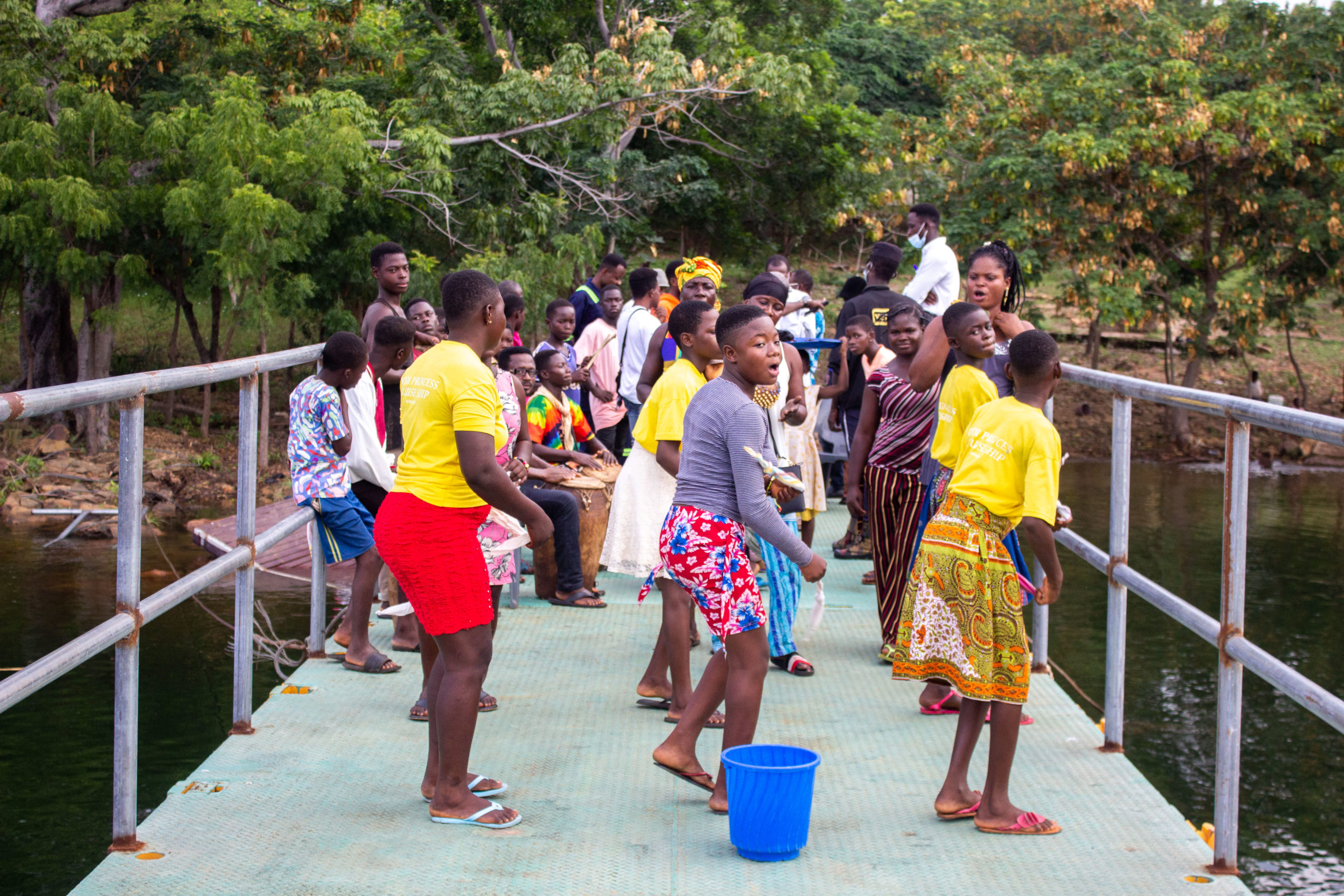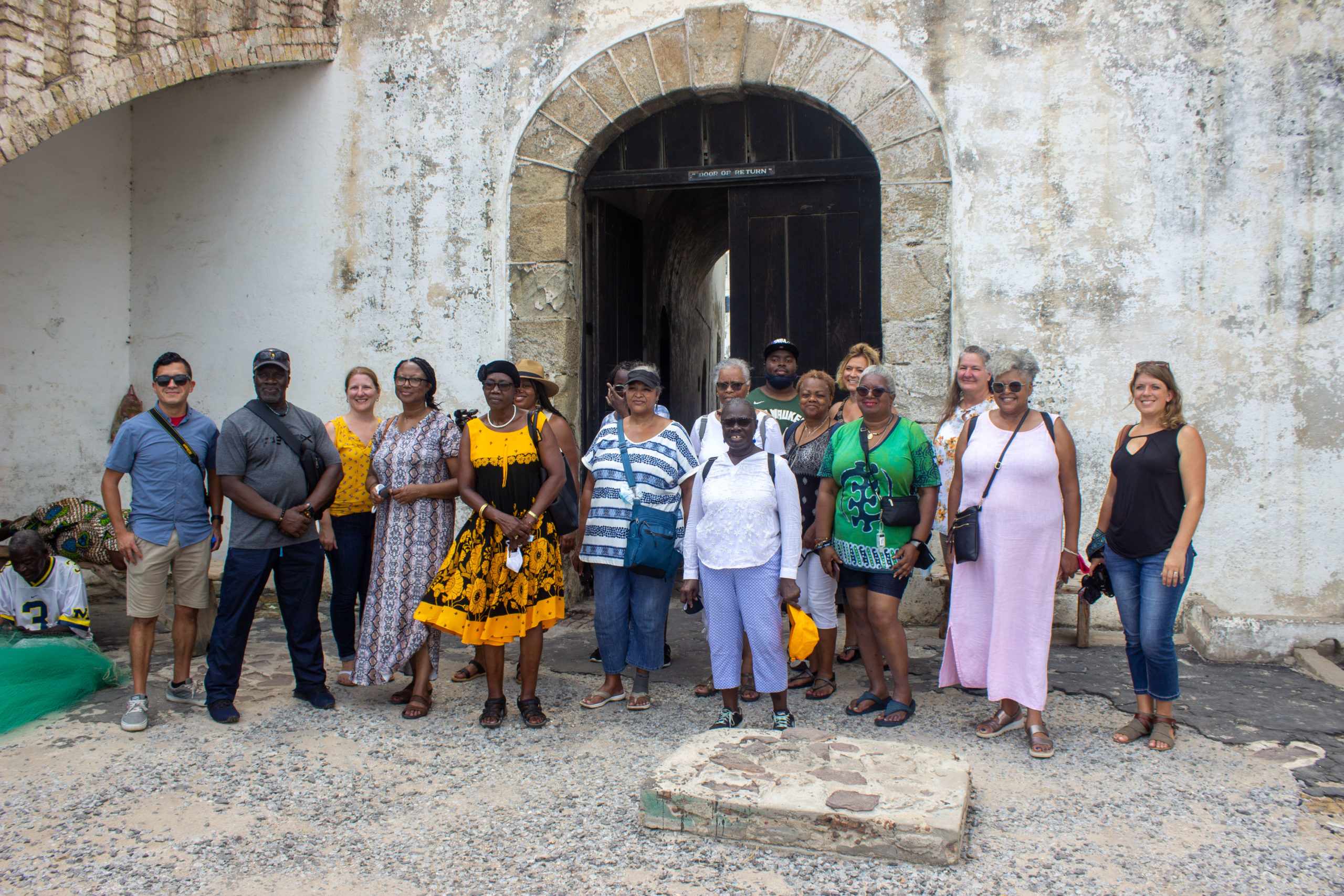
Rebecca Christian, a pilgrim on the trip to Ghana whose family members are members of All Saints Parish, shows her camera to local children. (Photos courtesy of Anthony Mensah)
For 15 days in early October, Antoinette Mensah, Ph.D., Director of World Mission Ministries, Office for World Mission – Society for the Propagation of the Faith, traveled with 18 pilgrims from the Archdiocese of Milwaukee to Ghana. Five of the young adults attended with the assistance of a grant from the Faith in Our Future Global Education Fund.
The pilgrimage, titled Sankofa, acknowledged 400 years since the first enslaved Africans arrived in America and 520 years since the first enslaved African was transported to Haiti (Hispaniola) and the Dominican Republic.
Sankofa is a West African term calling individuals or people to look to their past for wisdom to discern their future.
Anna Grosh, 35, a member of Holy Apostles Parish in New Berlin, works as an artist and art educator. She decided to travel on the pilgrimage because of the country’s focus on arts, culture and historical narrative, as those areas of focus relate to spirituality and faith.
“I learned much about the trans-Atlantic slave trade and learned about it from a very different perspective, through a different lens, and for that, I am very appreciative,” Grosh said.
Angel Rejon, 36, and a member of St. Francis de Sales in Lake Geneva, had similar reasons for joining the pilgrimage.
“When the Ghanaian concept of Sankofa, ‘go back and get it,’ was presented to me as the theme of this pilgrimage, I became very interested and wanted to experience it firsthand. Because of my experiences (on) this trip, to me, Sankofa is to take from the past what is good and carry it to the present to affect the future.”
While looking at the past, the pilgrims are also were able to see reasons for hope for the future.
The pilgrims traveled to Accra, the capital city of Ghana; Akosombo, where they traveled to Hohoe in the Volta Region; and visited the Tafi Monkey Sanctuary. They saw Korforidua, Kumasi, Prestea, Sekondi, Takoradi and Assin Manso. While the trip was exciting, prayerful and informative, for Mensah, it held special significance. She was able to visit Elmina, her birthplace, and her father’s hometown of Prestea.
“What was significant about that is there is a school that Fr. (James Kobina) Arthur (pastor of All Saints Parish and St. Martin de Porres) has been helping to build for 20 years. It is now two-thirds complete with a top-level roof, bathrooms, science lab, teachers’ lounge, and lunchroom,” she said. “He was on our trip, too, and joined in with a dance group who performed for us.”
Prestea Catholic School is of particular significance to Fr. Arthur, as he attended the school as a child. The school had become dilapidated, so with Archbishop Jerome E. Listecki’s blessing, he began fundraising for the new school. Upon their arrival at the school, they were to be greeted by the schoolchildren. However, the pilgrims ended up arriving late due to their bus getting stuck on the muddy highway.
“Because of the major delay, we didn’t expect to see the children. We got there an hour after they should have gone home,” Mensah said. “But, we were greeted by 800 enthusiastic school children from kindergarten through senior level. They greeted us and sang their national anthem. It was moving to see all these children who could have gone home but insisted on waiting for the red bus to show up.”
Before traveling on the Sankofa Pilgrimage, Grosh said she has traveled on several other pilgrimages, as well as other mission trips.
“This trip reinforced how meaningful and unique each journey is,” she said. “I will carry what I needed to hear and what I learned on this pilgrimage with me to the next adventure.”
In addition to learning more of the area, the group attended daily Mass, learned more of the history in Ghana, experienced the culture and enjoyed the references to God in nearly every aspect of the country.
“They have places like ‘In Jesus Name Barber Shop,’ ‘God Provides Taxi Service,’ and really everything, including many of the street names,” Mensah said. “The majority of people are Christian in the community. There is also an Islamic population, but they all seem to get along well.”









